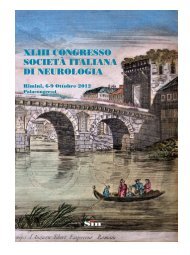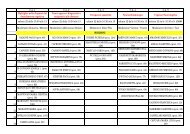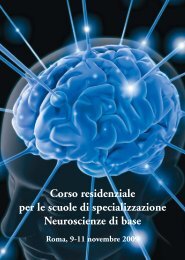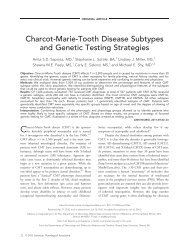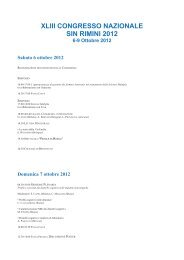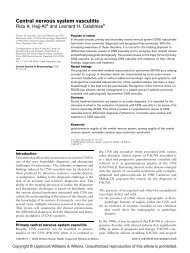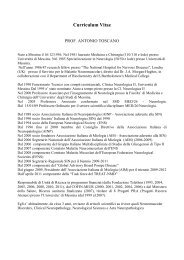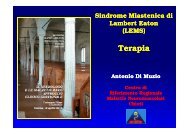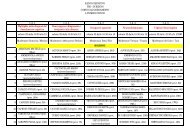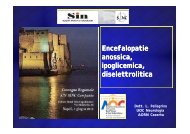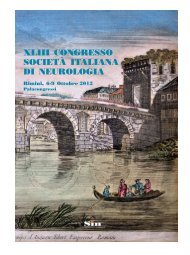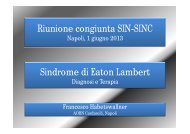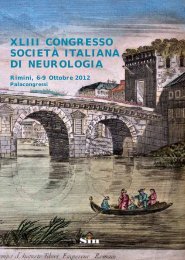Glucose transporter-1 deficiency syndrome: the expanding clinical ...
Glucose transporter-1 deficiency syndrome: the expanding clinical ...
Glucose transporter-1 deficiency syndrome: the expanding clinical ...
- No tags were found...
Create successful ePaper yourself
Turn your PDF publications into a flip-book with our unique Google optimized e-Paper software.
Clinical and genetic spectrum of GLUT1DS Brain 2010: 133; 655–670 | 667patients with <strong>the</strong> non-classical phenotype (0.41; SD 0.044;P = 0.005) (Fig. 2). The CSF glucose value did not differ significantlybetween patients with <strong>the</strong> early-onset classical (1.7 mmol/l;SD 0.35), late-onset classical (1.9 mmol/l; SD 0.30), ornon-classical phenotype (1.8 mmol/l; SD 0.19; P = 0.145). CSF lactatedid not differ significantly between patients with <strong>the</strong>early-onset classical (1.03 mmol/l; SD 0.27), late-onset classical(1.16 mmol/l; SD 0.18), or non-classical phenotype (0.94 mmol/l;SD; 0.15; P = 0.264).DiscussionOur data confirm <strong>the</strong> wide <strong>clinical</strong> spectrum of GLUT1 <strong>deficiency</strong><strong>syndrome</strong> as recently described (Brockmann, 2009). The absenceof epilepsy in patients with GLUT1 <strong>deficiency</strong> <strong>syndrome</strong> is considereduncommon and has only been described in a small number ofpatients (Overweg-Plandsoen et al., 2003; Hennecke et al., 2005;Friedman et al., 2006; Klepper et al., 2007). We have, however,identified a relatively large number of patients in our cohort (n =8;15%) with <strong>the</strong> non-classical phenotype of mental retardation andmovement disorders without epilepsy. Ano<strong>the</strong>r non-classical phenotypeof paroxysmal exercise-induced dyskinesia was recentlydescribed (Suls et al., 2008; Weber et al., 2008; Schneider etal., 2009). We did not identify patients with <strong>the</strong> latter phenotypein our study cohort, but we expect that with <strong>the</strong> increasing awarenessof <strong>the</strong> <strong>clinical</strong> variety of GLUT1 <strong>deficiency</strong> <strong>syndrome</strong>, diagnosiswill be made more frequently in patients with a non-classicalphenotype.Recognizing GLUT1 <strong>deficiency</strong> <strong>syndrome</strong> is important since itcan be treated with a ketogenic diet. The ketogenic diet is ahigh-fat, low carbohydrate, normocaloric diet which results in permanentketosis and provides <strong>the</strong> brain with an alternative fuel(Klepper et al., 2004). It is currently believed that <strong>the</strong> ketogenicdiet should be initiated as soon as possible and should be maintainedat least until adolescence (Klepper et al., 2005; Brockmann,2009). In our study cohort, <strong>the</strong> ketogenic diet was effective inmost of <strong>the</strong> patients with epilepsy (86%) and also reduced movementdisorders significantly in 48% of <strong>the</strong> patients with <strong>the</strong> classicalphenotype and 71% of <strong>the</strong> patients with a non-classicalphenotype. Effectiveness of <strong>the</strong> ketogenic diet in a series ofdrug-resistant epileptic patients with GLUT1 <strong>deficiency</strong> <strong>syndrome</strong>has previously been described (Klepper et al., 2005), but improvementof movement disorders in patients with a non-classical phenotypehas only been observed in case reports (Friedman et al.,2006; Brockmann, 2009). Our study underlines <strong>the</strong> importance ofinitiating a ketogenic diet, not only in patients with epilepsy, butalso in patients with movement disorders without epilepsy.Although subjective improvement of cognitive function, behaviourand alertness was reported in a substantial number of our patients,no objective data exist on <strong>the</strong> effect of <strong>the</strong> ketogenic diet oncognitive function. Prospective follow-up studies with standardizedneurocognitive tests are needed.The delay in diagnosing GLUT1 <strong>deficiency</strong> <strong>syndrome</strong> is considerable.Patients with <strong>the</strong> classical phenotype were diagnosed at anaverage of 6.6 years after <strong>the</strong> onset of seizures (range 1 month–16 years) (Tables 2 and 3). Our study demonstrates that a lumbarpuncture provides <strong>the</strong> diagnostic clue to GLUT1 <strong>deficiency</strong> <strong>syndrome</strong>and can <strong>the</strong>reby dramatically reduce diagnostic delay toallow early start of <strong>the</strong> ketogenic diet. All GLUT1 <strong>deficiency</strong> <strong>syndrome</strong>patients in our cohort had a low CSF glucose concentration(52.5 mmol/l) and all but one patient had a low CSF : blood glucoseratio (50.50). Differentiation with o<strong>the</strong>r causes of a low CSFglucose and low CSF : blood glucose ratio (bacterial, fungal, orprotozoal meningitis and subarachnoidal haemorrhage) can bemade not only on <strong>the</strong> <strong>clinical</strong> symptoms or CSF cultures, butalso on CSF lactate concentrations. Neurons can use lactate asan alternative fuel under circumstances of hypoglycaemia. A lowCSF lactate in most patients with GLUT1 <strong>deficiency</strong> <strong>syndrome</strong> is<strong>the</strong>refore thought to reflect <strong>the</strong> glucose shortage in <strong>the</strong> brain(Wang et al., 2006). CSF lactate was below 1.6 mmol/l in allour patients and below 1.3 mmol/l in 78% of <strong>the</strong> patients,whereas CSF lactate is elevated (42.0 mmol/l) in meningitis andsubarachnoidal haemorrhage (Cameron et al., 1993). Fur<strong>the</strong>rmore,CSF cell count and protein are normal in GLUT1 <strong>deficiency</strong> <strong>syndrome</strong>.We <strong>the</strong>refore advise to perform a lumber puncture inpatients with drug-resistant epilepsy and mental retardation, aswell as in patients with unexplained movement disorders, especiallyif movement disorders worsen or occur after fasting or exercise.Patients with paroxysmal exercise-induced dyskinesia due toGLUT1 <strong>deficiency</strong> <strong>syndrome</strong> have been observed in <strong>the</strong> absence ofmental retardation, migraine or epilepsy (Schneider et al., 2009).Notably, in patients with GLUT1 <strong>deficiency</strong> <strong>syndrome</strong> with thisnon-classical phenotype of familial exercise-induced dyskinesia<strong>the</strong> CSF is less sensitive for diagnosing GLUT1 <strong>deficiency</strong><strong>syndrome</strong>, as normal values for CSF : blood glucose ratio (0.47–0.60; mean 0.52) and CSF glucose (1.8–3.6 mmol/l; mean2.4 mmol/l) can be found (Suls et al., 2008).Our results demonstrate that GLUT1 <strong>deficiency</strong> <strong>syndrome</strong> iscaused by (partial) deletion of <strong>the</strong> SLC2A1 gene in at least 10%of <strong>the</strong> patients with GLUT1 <strong>deficiency</strong> <strong>syndrome</strong> confirmed byDNA analysis. To date, only five GLUT1 <strong>deficiency</strong> <strong>syndrome</strong>patients with a large scale deletion have been reported (De Vivoet al., 1991; Seidner et al., 1998; Wang et al., 2000; Vermeeret al., 2007). Perhaps, multiple exon deletions of a SLC2A1 alleleare under-diagnosed at <strong>the</strong> DNA level as a cause of GLUT1 <strong>deficiency</strong><strong>syndrome</strong>. We advise using multiplex ligation-dependentprobe amplification in every patient suspected of GLUT1 <strong>deficiency</strong><strong>syndrome</strong>, especially in patients with an early-onset classicalphenotype, since all patients identified with a multiple exon deletionhad this phenotype. By performing multiplexligation-dependent probe amplification in combination withSanger-based automated sequencing we were able to confirm suspicionof <strong>the</strong> <strong>clinical</strong> and/or biochemical diagnosis of GLUT1 <strong>deficiency</strong><strong>syndrome</strong> at <strong>the</strong> DNA level in 42% of all requests for DNAanalysis of <strong>the</strong> SLC2A1 gene. Regulatory sequences of <strong>the</strong> SLC2A1gene, e.g. promoter sequences and/or sequences deep in intronsare not included in <strong>the</strong> molecular diagnostic strategy. Possiblemutations in <strong>the</strong>se regions thus may not have been uncovered.We identified 13 novel missense mutations in <strong>the</strong> SLC2A1 gene.Eleven of <strong>the</strong>se missense mutations were found in patients with<strong>the</strong> classical phenotype of GLUT1 <strong>deficiency</strong> <strong>syndrome</strong> of epilepsyand mental retardation in combination with movement disordersand a characteristic CSF pattern, which would support <strong>the</strong>Downloaded from http://brain.oxfordjournals.org at centro sperimentale di medicina e biotecnologie-cnr on August 5, 2010



